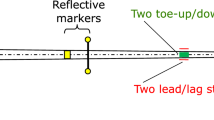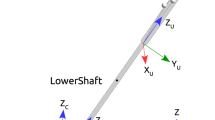Abstract
Golf shafts are normally characterised using static or quasi-static tests, yet the golf swing itself is dynamic. The purpose of this research was to determine whether stiffness properties obtained from these tests can be used when modelling the dynamic behaviour of golf shafts made from carbon fibre reinforced polymer (CFRP). Three shafts, matched for all properties except shaft flex, were subjected to human swing testing by 12 skillful players whilst strains were recorded. Peak principal strains as well as strain rates increased as shaft flex decreased (p < 0.001). CFRP flat panels with lay-ups similar to those contained in the shafts were constructed and tested statically and at strain rates between 10−4 and 4 s−1. Some level of strain-rate dependency was found for these panels, but only for strain rates exceeding those seen during a swing, which suggests that static material tests are appropriate for measuring the dynamic stiffness of golf shafts.







Similar content being viewed by others
References
Strangwood M (2003) Materials in golf. In: Jenkins M (ed) Materials in sports equipment. Woodhead, Cambridge, pp 129–159
Cheong SK, Kang KW, Jeong SK (2006) Evaluation of the mechanical performance of golf shafts. Eng Fail Anal 13(3):464–473. doi:10.1016/j.engfailanal.2004.12.035
Howell DD (1992) The design of filament wound graphite/epoxy golf shafts. In: Grimes G (ed) Materials working for you in the 21st century. 37th international SAMPE symposium. SAMPE, Anaheim, pp 1392–1405
McClung AJW, Ruggles-Wrenn MB (2008) The rate (time)-dependent mechanical behavior of the PMR-15 thermoset polymer at elevated temperature. Polym Test 27(7):908–914. doi:10.1016/j.polymertesting.2008.07.007
Gilat A, Goldberg RK, Roberts GD (2002) Experimental study of strain-rate-dependent behavior of carbon/epoxy composite. Compos Sci Technol 62(10–11):1469–1476. doi:10.1016/S0266-3538(02)00100-8
Vinson JR, Woldesenbet E (2001) Fiber orientation effects on high strain rate properties of graphite/epoxy composites. J Compos Mater 35(6):509–521. doi:10.1177/002199801772662136
MacKenzie S, Sprigings E (2009) Understanding the role of shaft stiffness in the golf swing. Sports Eng 12(1):13–19. doi:10.1007/s12283-009-0028-1
Swanek D, Carey J (2007) Braided composite materials for the production of lightweight, high rigidity golf shafts. Sports Eng 10(4):195–208. doi:10.1007/bf02933571
Kenny I, McCloy A, Wallace E, Otto S (2008) Segmental sequencing of kinetic energy in a computer-simulated golf swing. Sports Eng 11(1):37–45. doi:10.1007/s12283-008-0005-0
Nesbit SM (2007) Development of a full-body biomechanical model of the golf swing. Int J Model Simul 27(4):392–404. doi:10.2316/Journal.205.2007.4.205-4599
Kenny IC, Wallace ES, Brown D, Otto SR (2006) Validation of a full-body computer simulation of the golf drive for clubs of differing length. In: Moritz EF, Haake S (eds) The engineering of sport 6, vol 2. Springer, New York, pp 11–16
Milne RD, Davis JP (1992) The role of the shaft in the golf swing. J Biomech 25(9):975–983. doi:10.1016/0021-9290(92)90033-W
Butler JH, Winfield DC (1994) The dynamic performance of the golf shaft during the downswing. In: Cochran AJ, Farrally MR (eds) Science and golf II: proceedings of the world scientific congress of golf. E & FN Spon, London, pp 259–264
Horwood GP (1994) Golf shafts—a technical perspective. In: Cochran AJ, Farrally MR (eds) Science and golf II: proceedings of the world scientific congress of golf. E & FN Spon, London, pp 247–258
Newman S, Clay S, Strickland P (1997) The dynamic flexing of a golf club shaft during a typical swing. In: Proceedings of the fourth annual conference on mechatronics and machine vision in practice. Toowoomba, Australila, pp 265–270
Lee N, Erickson M, Cherveny P (2002) Measurement of the behaviour of a golf club during the golf swing. In: Thain E (ed) Science and golf IV: proceedings of the world scientific congress of golf. Routledge, London, pp 374–385
Huntley MP, Davis CL, Strangwood M, Otto SR (2006) Comparison of the static and dynamic behaviour of carbon fibre composite golf club shafts. Proceedings of the institution of mechanical engineers part L. J Mater Des Appl 220(L4):229–236. doi:10.1243/14644207JMDA74
Weeks CA, Sun CT (1998) Modeling non-linear rate-dependent behavior in fiber-reinforced composites. Compos Sci Technol 58(3–4):603–611. doi:10.1016/S0266-3538(97)00183-8
Slater C, Otto SR, Strangwood M (2010) The quasi-static and dynamic testing of damping in golf clubs shafts fabricated from carbon fibre composites. Procedia Eng 2(2):3361–3366. doi:10.1016/j.proeng.2010.04.158
Huntley MP, Davis CL, Strangwood M (2004) Characterisation of ‘seams’ in carbon-fibre composite golf shafts. In: Hubbard M, Mehta RD, Pallis JM (eds) The engineering of sport 5, vol 2. International Sports Engineering Association, Sheffield, pp 223–229
Huntley MP (2007) Comparison of static and dynamic carbon fibre composite golf club shaft properties and their dependence on structure. PhD thesis, University of Birmingham
Sun CT, Kim W (2002) Modeling relaxation of a polymeric composite during loading and unloading. J Compos Mater 36:745–755. doi:10.1177/0021998302036006477
R&A Rules Limited (2007) Procedure for measuring the length of golf clubs (excluding Putters)—Protocol. http://www.randa.org/en/Equipment/Protocols%20and%20Procedures/Clubs/Club%20Length.aspx. Accessed 19th August 2010
Maltby RD (1995) Golf club design, fitting, alteration, and repair: the principles and procedures. R. Maltby Enterprises, Newark
Hocknell A, Jones R, Rothberg S (1996) Experimental analysis of impacts with large elastic deformation: I. Linear motion. Meas Sci Technol 7(9):1247–1254. doi:10.1088/0957-0233/7/9/009
Roberts JR, Jones R, Rothberg SJ (2001) Measurement of contact time in short duration sports ball impacts: an experimental method and correlation with the perceptions of elite golfers. Sports Eng 4(4):191–203. doi:10.1046/j.1460-2687.2001.00084.x
Conflict of interest
The authors declare that they have no conflict of interest.
Author information
Authors and Affiliations
Corresponding author
Appendix
Appendix
Based on the definitions provided in Fig. 8, it is possible to find the following relationship between measured and principal strain:
where ε a/b is the magnitude of the strain at positions a or b (μm/m), ε is the magnitude of the principal strain (μm/m), φ ε is the orientation of the principal strain (rad), and φ a/b is the orientation of positions a and b (rad).
Rearranging (3) yields:
It is further possible to calculate the principal strain for any given output from the two strain gauges at positions a and b from Eq. (3):
Rights and permissions
About this article
Cite this article
Betzler, N.F., Slater, C., Strangwood, M. et al. The static and dynamic stiffness behaviour of composite golf shafts and their constituent materials. Sports Eng 14, 27 (2011). https://doi.org/10.1007/s12283-011-0068-1
Published:
DOI: https://doi.org/10.1007/s12283-011-0068-1





